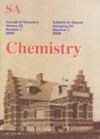Speciation Study of L-ascorbic Acid and its Chelated Cu(II) & Ni(II) Complexes: an Experimental and Theoretical Model of Complex Formation
IF 1
4区 化学
Q4 CHEMISTRY, MULTIDISCIPLINARY
South African Journal of Chemistry-Suid-Afrikaanse Tydskrif Vir Chemie
Pub Date : 2019-01-01
DOI:10.17159/0379-4350/2019/v72a30
引用次数: 5
Abstract
Different species of L-ascorbic acid and their corresponding complex formation ability with Cu(II) and Ni(II) metal ions in aqueous medium has been studied in the pH range from 2.0–12.5. The stability constants of different complexes of Cu(II) and Ni(II) with the bidentate ligand, L-ascorbic acid were determined theoretically using MINIQUARD software. Speciation of ligand and complex of Cu(II)/Ni(II) ascorbate were experimentally investigated by the titration method in solution within this pH range. Different Cu (II) and Ni(II)-L-ascorbic acid species percentages with variation of pH were calculated within the studied pH range with the help of another computer programs SIM and SPECIES. Different species distribution diagrams and the equilibria for the formation of the species were also investigated and at higher pH, ML2 species was found to be the major species in the case of both the metal complexes. All the theoretical possible structures of Cu(II) and Ni(II) complexes with L-ascorbic acid were optimized and square pyramidal and square planer geometry have been evaluated for Cu(II) and Ni(II) respectively by Gaussian09 software. Their corresponding HOMO-LUMO energy and reactivity parameters such as chemical hardness (ç), ionization potential (I), electron affinity (A), electro negativity (÷), chemical potential (ì), electrophilicity index (ù) have been calculated in order to provide a better understanding of the electronic structure of complexes with the experimental results.l -抗坏血酸及其螯合Cu(II)和Ni(II)配合物的形态研究:配合物形成的实验和理论模型
研究了不同种类的l -抗坏血酸在pH为2.0 ~ 12.5的水溶液中与Cu(II)和Ni(II)金属离子形成络合物的能力。用MINIQUARD软件对Cu(II)和Ni(II)与双齿配体l -抗坏血酸配合物的稳定性常数进行了理论测定。在此pH范围内,用滴定法研究了Cu(II)/Ni(II)抗坏血酸盐配体和配合物的形态。在研究的pH范围内,利用另一个计算机程序SIM和species计算不同Cu (II)和Ni(II)- l -抗坏血酸的种类百分比随pH的变化。结果表明,在较高的pH条件下,两种金属配合物均以ML2物种为主。对Cu(II)和Ni(II)与l -抗坏血酸配合物的所有可能的理论结构进行了优化,并利用Gaussian09软件分别对Cu(II)和Ni(II)进行了方锥体和方平面几何的评价。计算了它们对应的HOMO-LUMO能量和反应性参数,如化学硬度(ç)、电离势(I)、电子亲和力(A)、电负性(÷)、化学势(ì)、亲电性指数(ù),以便与实验结果更好地理解配合物的电子结构。
本文章由计算机程序翻译,如有差异,请以英文原文为准。
求助全文
约1分钟内获得全文
求助全文
来源期刊
CiteScore
3.10
自引率
0.00%
发文量
6
审稿时长
>12 weeks
期刊介绍:
Original work in all branches of chemistry is published in the South African Journal of Chemistry. Contributions in English may take the form of papers, short communications, or critical reviews.

 求助内容:
求助内容: 应助结果提醒方式:
应助结果提醒方式:


